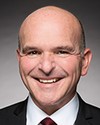Thank you, Chair.
I am pleased to appear before the committee to discuss the link between the Government of Canada's immigration measures and official languages.
I have some brief opening remarks, and I'll be happy to take questions after that.
As the committee members likely know, in late 2017 our government announced a plan to pursue the most ambitious immigration levels in Canadian history because we know that immigration positively contributes to both the Canadian economy and our society. We have a plan to steadily increase our immigration levels.
This plan includes efforts geared specifically at francophone immigration, which plays an important role in Canada's future.
To that end, the federal government plans to support and help francophone communities outside Quebec by contributing to francophone immigration and adopting measures in support of such immigration.
Mr. Chair, we continue working toward achieving the target of 4.4% francophone migration by 2023.
To fulfill that commitment, IRCC has already made changes to its programs for French-speaking immigrants.
In 2016, IRCC adjusted the express entry system to make it easier for all temporary foreign workers and international students to become permanent residents. We expect French-speaking immigrants to benefit from these changes. In 2017, to increase the proportion of French-speaking immigrants coming to Canada through economic programs, we awarded additional points under the express entry system to immigration applicants with strong proficiency in French.
We are already seeing positive trends resulting from these changes, even though it's been a very short period of time since these changes have been implemented. The number of French speakers, therefore, invited to apply to come to Canada under the express entry system has now doubled. That is a huge achievement as a result of the change to express entry.
In 2016 we also introduced the mobilité francophone system, which helps employers outside of Quebec hire French-speaking workers from abroad to undertake skilled work, and in exchange for taking a chance on that worker they get a break on the labour market impact assessment. In 2017 we adjusted this stream to facilitate the recruitment of even more French-speaking temporary workers.
We also continued our promotion and recruitment efforts to sell Canada as a destination of choice for French-speaking immigrants. This includes taking part in targeted initiatives such as Destination Canada fairs, which are very effective in Europe, and other similar events in Europe and Africa.
On March 28 of this year, the Minister of Canadian Heritage introduced our government's overall action plan for official languages for 2018 to 2023. As part of this plan, Immigration, Refugees and Citizenship Canada is committed to supporting the vitality of francophone minority communities.
I'm pleased to also highlight that budget 2018 allocated $40.8 million in new funding over five years to IRCC.
IRCC plans to consolidate what we refer to as the francophone integration pathway to official language minority communities, and to enhance collaboration and accountability within the department.
Our work with the francophone integration pathway will entail the following: strengthening connections between French-speaking immigrants, improving the provision of francophone settlement services, and building the capacity of the francophone settlement services sector. This initiative will help French-speaking newcomers to obtain the information they need regarding francophone communities and services from francophone settlement organizations.
To accomplish this, it will cover the entire integration spectrum, from pre-arrival all the way to citizenship.
I am pleased to note that part of this francophone integration pathway includes adding more francophone service providers at some international airports in Canada. We are starting with the LB Pearson International Airport, a major point of interest for immigrants to Canada.
The francophone integration pathway will also work to increase the availability and accessibility of French-language training that is adapted to the needs of French-speaking immigrants. For example, it will expand online learning tools so that French-speaking newcomers can access the learning opportunities they need to achieve their unique settlement goals.
We are also improving the availability of professional development in French for francophone settlement service providers, including for service delivery coordination networks, the Francophone immigration networks. We have 13 such networks from coast to coast, in every province and territory except for Quebec and Nunavut.
Another part of the francophone integration pathway announced in the federal action plan is a new initiative called “welcoming francophone communities”. This will help targeted communities to improve their capacity to help French-speaking newcomers integrate and remain in these communities via enhanced services and programs. We're also aiming to increase the availability of French-language tests at a lower cost. Currently, we're working with independent language-testing organizations to provide these services to potential economic immigrants.
Finally, we plan to improve the coordination of francophone immigration services at IRCC itself, with increased horizontal policy engagement and the creation of a francophone immigration policy hub within IRCC. This hub will reinforce the capacity of the department to review and revise activities in relation to francophone immigration.
IRCC is also working with a number of partners, including the provinces, territories, and francophone communities on developing a new comprehensive francophone immigration strategy to improve the coherence of the activities meant to support French-speaking newcomers and contribute to achieving the targets set for francophone immigration outside Quebec.
These measures will also be a complement to our plan for enhancing our accountability, reporting, and performance measures, as well as our ability to evaluate the impact of the department's measures when it comes to official languages.
Over much of this year, I met with provincial and territorial ministers responsible for immigration. I also met with the Canadian francophonie in Toronto at the second forum on francophone immigration. This was an opportunity to discuss initiatives that encourage francophone immigrants to settle in francophone minority communities outside of Quebec in Canada and that help these immigrants to remain in these communities.
Ministers in attendance endorsed the first-ever federal-provincial-territorial action plan for increased francophone immigration outside of Quebec. This plan outlines concrete actions that our different jurisdictions can take. These include promoting awareness of francophone immigration opportunities; the provision of immigration pathways and settlement services to prospective French-speaking immigrants and applicants; increasing employer engagement in French-speaking immigrant recruitment and employment; increasing the availability, awareness, and accessibility of French- language services; and supporting diverse and inclusive francophone communities.
By pursuing these initiatives, this plan will contribute to an increase in the number of French-speaking immigrants settling in Canada outside of Quebec.
The participation rate of French-speaking immigrants in local labour markets is also set to increase. What will also increase is the participation rate of French-speaking immigrants in broader communities and social networks. I should add that, following the FPT forum, a symposium bringing together governments and community organizations was held on March 22 this year in Calgary. This event laid the foundation for potential collaboration between governments and communities to strengthen francophone immigration to Canada, including the FPT action plan.
Before closing, Mr. Chair, I should note that recently I joined the Honourable Laura Albanese, Ontario Minister of Citizenship and Immigration, to sign three new annexes to the Canada-Ontario Immigration Agreement. One of these annexes was the French-speaking immigrant annex, which will help Canada and Ontario identify opportunities to increase the number of French-speaking immigrants coming to Canada and Ontario. I had previously signed a similar annex with my counterpart in New Brunswick.
This is just one of the ways in which the federal and provincial governments are working together to maximize the economic, social, and cultural benefits of immigration. To this end, our priority on increasing francophone immigration outside of Quebec will help address these challenges and support the vitality of our francophone communities.
Our government recognizes that the bilingual nature of Canada reinforces both our society and our economy. While we have work to do to reach this goal, we'll continue to make significant progress that supports French-speaking immigrants.
Under the new measures in the Action Plan for Official Languages, we are allocating funds directly to francophone minority communities and improving their ability to integrate and retain French-speaking immigrants.
We want every community in Canada to benefit from immigration and we want to encourage French-speaking immigrants to settle and get established in every community in our country.
Thank you, Mr. Chair.
We will now be pleased to take your questions.












